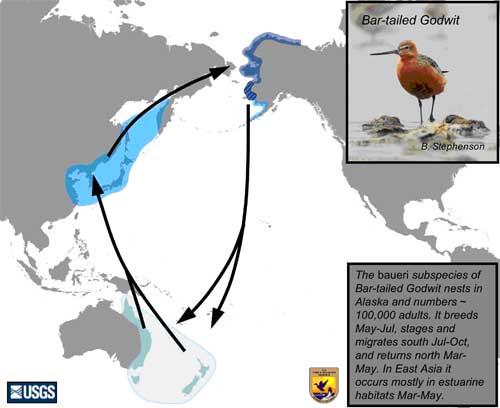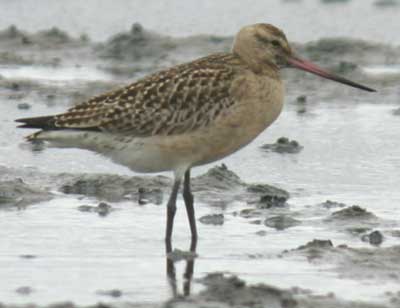Bar-tailed Godwit, Limosa lapponica
High-Priority Species ListSampling locations: The primary sampling effort will occur during autumn staging when the entire Alaskan population is located along the coast of southwest Alaska. Because the specific distribution of post-breeding migrants in space and time within the staging distribution has not been determined for birds nesting in different areas of Alaska, sampling should span the geographic and temporal range of the staging population. Specific locations include three sites on the Yukon-Kuskokwim Delta (Tutakoke River, Tern Mountain, Kuskokwim Shoals) and one on the Alaska Peninsula (Egegik). In past years, accessible roosts have been found at all locations. Under similar conditions, the collection of > 200 individual samples/site would be feasible. Secondary sampling will occur on the YKD among spring staging birds at Tutakoke River (up to 100 cloacal swabs and/or fecal samples) and breeding birds at Old Chevak (up to a few dozen cloacal swabs and/or fecal samples). Sampling of breeders will also occur on the Seward Peninsula and/or on the Colville River Delta in northern Alaska.
Sampling timeframe: Primary sampling will occur in August-September on the coast of YKD and Alaska Peninsula. Secondary sampling will occur during May at Tutakoke, May-July at Old Chevak, and June-July on the Seward Peninsula and Colville River Delta.
Sample demographics: Adults will be sampled during spring migration and on the breeding grounds. Both adults and juveniles will be sampled during autumn staging, although the relative proportion of the age classes sampled will likely vary among sites.
Methods of capture: The sample goal can most easily be achieved through fecal sampling at on-shore roost sites in autumn. Smaller numbers of samples can be obtained from fecal sampling and/or live capture (~20-40 birds/site) of adults at the 3-4 secondary sampling sites.
Other targeted species: At the proposed primary sampling sites it will be possible to sample moderate to large numbers of Sharp-tailed Sandpipers, Dunlins, and Rock Sandpipers.
Contact: Brian McCaffery
U.S. Geological Survey
Contact: Robert Gill
Battley, P. F. 1997. The northward migration of arctic waders in New Zealand: departure behaviour, timing, and possible migration routes of Red Knots and Bar-tailed Godwits from Farewell Spit, north-west Nelson. Emu 97:108-120.
Gill, R. E., Jr., T. Piersma, G. Hufford, R. Servranckx, and A. Riegen. 2005. Crossing the ultimate ecological barrier: evidence for an 11,000-km-long nonstop flight from Alaska to New Zealand and eastern Australia by Bar-tailed Godwits. Condor 107:1-20.
McCaffery, B., and R. Gill. 2001. Bar-tailed Godwit (Limosa lapponica). In The Birds of North America, No. 581 (A. Poole and F. Gill, eds.). The Birds of North America, Inc., Philadelphia, PA.
Wilson, J. R, and M. A. Barter. 1998. Identification of potentially important staging areas of "long jump" migration waders in the east Asian-Australasian flyway during northward migration. Stilt 32:16-27.

Ranking Score: 14.0 (With the inclusion of fecal sampling, the ease of sampling would change from 2 to 3, and the overall score would rise to 15)
Asian H5N1 ranking criteria for Bar-tailed Godwit, Limosa lapponica.
Total of partial contact with Asia1 |
Contact with known "hot spot"2 |
Habitat used in Asia3 |
Pop. in Alaska4 |
Can samples be obtained? |
Score |
5.0 |
2.0 |
2.0 |
3.0 |
2.0 |
14.0 |
Entire pop. nests w. and n. Alaska & stages c.e. Asia (Yellow Sea, Korea, Japan) in spring; southward migration direct across Pacific |
On migration stops in central e. Asia (Yellow Sea, Korea, Japan) |
Estuarine |
Est. at 120,000, but 2005 census efforts accounted for <50,000 |
Could be difficult to obtain target number |

